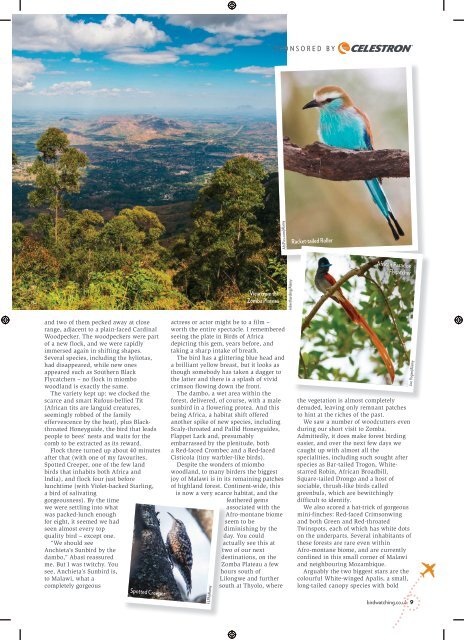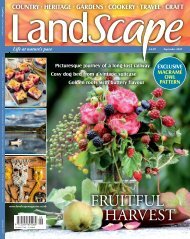BWT Travel Guide
Create successful ePaper yourself
Turn your PDF publications into a flip-book with our unique Google optimized e-Paper software.
SPONSORED BY<br />
AfriPics.com/Alamy<br />
Racket-tailed Roller<br />
African Paradise<br />
Flycatcher<br />
View from the<br />
Zomba Plateau<br />
robertharding/Alamy<br />
and two of them pecked away at close<br />
range, adjacent to a plain-faced Cardinal<br />
Woodpecker. The woodpeckers were part<br />
of a new flock, and we were rapidly<br />
immersed again in shifting shapes.<br />
Several species, including the hyliotas,<br />
had disappeared, while new ones<br />
appeared such as Southern Black<br />
Flycatchers – no flock in miombo<br />
woodland is exactly the same.<br />
The variety kept up: we clocked the<br />
scarce and smart Rufous-bellied Tit<br />
(African tits are languid creatures,<br />
seemingly robbed of the family<br />
effervescence by the heat), plus Blackthroated<br />
Honeyguide, the bird that leads<br />
people to bees’ nests and waits for the<br />
comb to be extracted as its reward.<br />
Flock three turned up about 40 minutes<br />
after that (with one of my favourites,<br />
Spotted Creeper, one of the few land<br />
birds that inhabits both Africa and<br />
India), and flock four just before<br />
lunchtime (with Violet-backed Starling,<br />
a bird of salivating<br />
gorgeousness). By the time<br />
we were settling into what<br />
was packed-lunch enough<br />
for eight, it seemed we had<br />
seen almost every top<br />
quality bird – except one.<br />
“We should see<br />
Anchieta’s Sunbird by the<br />
dambo,” Abasi reassured<br />
me. But I was twitchy. You<br />
see, Anchieta’s Sunbird is,<br />
to Malawi, what a<br />
completely gorgeous<br />
Spotted Creeper<br />
actress or actor might be to a film –<br />
worth the entire spectacle. I remembered<br />
seeing the plate in Birds of Africa<br />
depicting this gem, years before, and<br />
taking a sharp intake of breath.<br />
The bird has a glittering blue head and<br />
a brilliant yellow breast, but it looks as<br />
though somebody has taken a dagger to<br />
the latter and there is a splash of vivid<br />
crimson flowing down the front.<br />
The dambo, a wet area within the<br />
forest, delivered, of course, with a male<br />
sunbird in a flowering protea. And this<br />
being Africa, a habitat shift offered<br />
another spike of new species, including<br />
Scaly-throated and Pallid Honeyguides,<br />
Flappet Lark and, presumably<br />
embarrassed by the plenitude, both<br />
a Red-faced Crombec and a Red-faced<br />
Cisticola (tiny warbler-like birds).<br />
Despite the wonders of miombo<br />
woodland, to many birders the biggest<br />
joy of Malawi is in its remaining patches<br />
of highland forest. Continent-wide, this<br />
is now a very scarce habitat, and the<br />
feathered gems<br />
associated with the<br />
Afro-montane biome<br />
seem to be<br />
diminishing by the<br />
day. You could<br />
actually see this at<br />
two of our next<br />
destinations, on the<br />
Zomba Plateau a few<br />
hours south of<br />
Lilongwe and further<br />
south at Thyolo, where<br />
FLPA/Alamy<br />
the vegetation is almost completely<br />
denuded, leaving only remnant patches<br />
to hint at the riches of the past.<br />
We saw a number of woodcutters even<br />
during our short visit to Zomba.<br />
Admittedly, it does make forest birding<br />
easier, and over the next few days we<br />
caught up with almost all the<br />
specialities, including such sought after<br />
species as Bar-tailed Trogon, Whitestarred<br />
Robin, African Broadbill,<br />
Square-tailed Drongo and a host of<br />
sociable, thrush-like birds called<br />
greenbuls, which are bewitchingly<br />
difficult to identify.<br />
We also scored a hat-trick of gorgeous<br />
mini-finches: Red-faced Crimsonwing<br />
and both Green and Red-throated<br />
Twinspots, each of which has white dots<br />
on the underparts. Several inhabitants of<br />
these forests are rare even within<br />
Afro-montane biome, and are currently<br />
confined in this small corner of Malawi<br />
and neighbouring Mozambique.<br />
Arguably the two biggest stars are the<br />
colourful White-winged Apalis, a small,<br />
long-tailed canopy species with bold<br />
Joe Vogan/Alamy<br />
birdwatching.co.uk 9

















